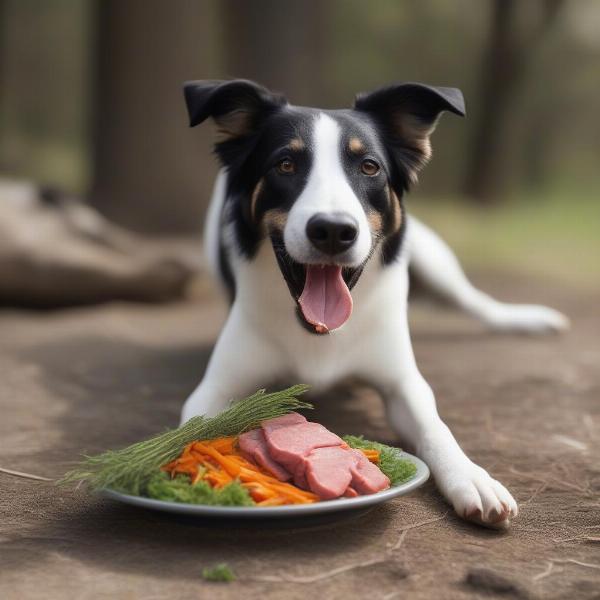Forage dog food is gaining popularity amongst dog owners seeking a more natural and enriching diet for their canine companions. This approach to feeding focuses on providing a variety of whole, unprocessed foods that mimic a dog’s ancestral diet. It’s not just about tossing your dog a carrot; it’s a carefully considered approach to nutrition that can offer significant benefits. This guide will explore what forage dog food is, its potential benefits and drawbacks, how to safely implement it, and what to consider when selecting the right ingredients.
What is Forage Dog Food?
Forage dog food, sometimes referred to as “prey model raw” or “Frankenprey,” moves away from traditional kibble and canned food, instead emphasizing fresh, whole ingredients. This diet typically includes raw meat, bones, organs, fruits, vegetables, and other natural components. The goal is to provide a diet that more closely resembles what a dog’s wild ancestors would have consumed.
Benefits of Forage Dog Food
Advocates of forage dog food often cite several potential benefits, including:
- Improved Digestion: The natural enzymes present in raw foods can aid digestion.
- Shinier Coat and Healthier Skin: A diet rich in essential fatty acids and nutrients can contribute to a healthier coat and skin.
- Increased Energy Levels: A balanced raw diet can provide sustained energy throughout the day.
- Better Dental Health: Chewing on raw bones can help scrape away plaque and tartar buildup.
- Reduced Allergies: Switching to a limited-ingredient raw diet may help identify and eliminate food allergens.
Risks and Considerations of Forage Dog Food
While forage feeding can offer advantages, it’s essential to be aware of the potential risks:
- Nutritional Deficiencies: Improperly balanced raw diets can lead to deficiencies in essential vitamins and minerals.
- Bacterial Contamination: Raw meat can harbor harmful bacteria like Salmonella and E. coli, posing a risk to both dogs and humans.
- Bone Splintering: Cooked bones are particularly prone to splintering, which can cause injury to a dog’s digestive tract. Only raw bones should be fed.
- Cost and Time Commitment: Sourcing and preparing a raw diet can be more expensive and time-consuming than using commercial dog food.
How to Start Forage Feeding Your Dog
If you’re considering transitioning your dog to a forage diet, consult with a veterinarian or a certified canine nutritionist. They can help you create a balanced meal plan and address any potential health concerns. Introduce new foods gradually to avoid digestive upset.
Choosing the Right Ingredients for Forage Dog Food
Selecting high-quality ingredients is crucial for a safe and nutritious forage diet. Opt for human-grade meat and poultry from reputable sources. Variety is key, offering different types of meat, organs, and produce to ensure a complete nutritional profile.
Is Forage Feeding Right for Your Dog?
Forage feeding can be a rewarding way to nourish your dog, but it requires careful planning and commitment. Consider your lifestyle, budget, and your dog’s individual needs before making the switch. If done correctly, it can provide a more natural and enriching dietary experience.  Dog Enjoying a Forage Meal
Dog Enjoying a Forage Meal
FAQ:
- Is forage dog food safe for puppies? Yes, but it’s especially crucial to consult with a veterinarian or canine nutritionist to ensure a balanced diet for growing puppies.
- Can I mix forage food with kibble? While some owners choose to mix, it’s generally recommended to feed either a fully raw or fully kibble diet to avoid digestive issues.
- Where can I buy ingredients for forage dog food? Local butchers, farmers’ markets, and online retailers specializing in raw pet food are good sources.
- How do I store raw dog food? Store raw meat and other ingredients in the freezer and thaw portions as needed.
- How often should I feed my dog a forage diet? Most adult dogs thrive on being fed once or twice a day.
- What are the signs of nutritional deficiencies in dogs? Signs can vary, but may include weight loss, lethargy, skin problems, and changes in coat quality.
- How can I ensure my dog’s forage diet is balanced? Working with a veterinary nutritionist is the best way to ensure balance.
Related Articles
ILM Dog is a leading international website dedicated to providing expert advice on all aspects of dog care and wellbeing. We offer valuable resources on dog breeds, health, training, nutrition, and much more, catering to both new and experienced dog owners worldwide. For personalized guidance on forage dog food and other dietary options, contact our team of experts at [email protected] or call us at +44 20-3965-8624. ILM Dog is committed to helping you provide the best possible care for your canine companion.